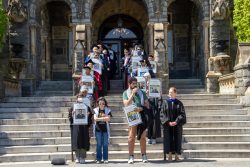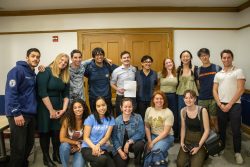GUSA released a report on Wednesday highlighting the impacts of the 2010 Campus Plan and what it expects from the 2018 Campus Plan, currently in its early stages. Additionally, it released a petition that demands that no additional students—beyond those the 2010 Campus Plan legally mandates—be required to live on campus, that the university renovate and maintain current buildings on campus before starting new construction projects, and that more student representation be added to Georgetown Community Partnership Steering Committee.
GUSA’s Our Georgetown website, which contains the petition, calls for students to let their voices be heard during the formation of the 2018 campus plan.
“We’re hoping the website will help mobilize students around the petition in the next few weeks, and will then transition into a more long-term role after the petition and April 11 GCP meeting,” Ari Goldstein (COL’18), Co-Chair of the GUSA Campus Plan Subcommittee, wrote in an email to the Voice.
In the report, Reno Varghese (SFS ‘16), Co-Chair of the GUSA Campus Plan Subcommittee, encouraged student participation in the formation process of the 2018 Campus Plan.
“We formed the Campus Plan Subcommittee in September expressly to prevent the mistakes of 2010 and ensure that this time, the student body is engaged, informed, and provided with a seat at the negotiating table,” Varghese wrote in the report. “The stakes have never been higher.”
The report outlines the different visions for the 2018 plans that the neighborhood, the university, and Medstar have. According the report, the neighborhood indicated during the 2010 planning that they would want 100 percent of undergraduate students living on campus. The university’s hopes that the plan include features such as expanded green space, improved transportation methods, and a more developed residential living and learning community.
Robin Morey, vice president for Planning and Facilities Management, did not respond to request for comment in time for print.
According to Jamie Scott, assistant director of Community Engagement, the university has worked to engage students in the campus planning process for the 2018 plan.
“Students are a really important part of [the planning] process.” Scott said. “We’ve had open community forum where students are invited, we created the master planning website that shares a lot of the information and ideas on the plan and invites people to read comment on those.” Scott added that events like the Hoya Roundtables engaged both student groups who have traditionally been involved in the planning process and those who have not.
Additionally, relations between the neighborhood and the students have improved in forming the 2018 campus plan compared with 2010, according Goldstein.
“There remain important differences between student and neighbor priorities, but the hostility of 2010 is hopefully a thing of the past,” Goldstein wrote in an email to the Voice.
The 2010 campus plan placed an enrollment cap of 14,106 on the total student population and required all students under the age of 21 to live on campus. It will increase the number of beds on campus by 385 by fall 2015.
“When students fail to organize effectively in the face of politically powerful neighborhood institutions, we end up with university agreements that accommodate neighborhood interests at the expense of students,” Goldstein wrote in the report’s closing letter of the 2010 plan. “It has played out time and time again, but we’re only now beginning to suffer the consequences of recent inaction.”
Goldstein continues to state that the various neighborhood associations pushed for a four year on campus housing requirement in 2010 and will likely do so again in 2018. Goldstein, though, called this “both unprecedented and unreasonable” in the report.
Despite GUSA’s call to students to take action to prevent a restrictive plan for students, Scott believes that the current procedure in place for creating the campus plan—with input from students, neighbors, and the university along with committees like the Georgetown Community Partnership—allows the goals of all three to align.
“I think our vision’s are aligned and I think there are shared goals and interests between the university and the community and students about what we want the campus to look like,” Scott said.
According to Goldstein, signing the petition is one way for students to express their opinion for what their goals and vision for the campus plan might be.
“[The petition] opposes additional on-campus housing requirements and demands that administrators prioritize long-needed renovations,” Goldstein wrote in an email to the Voice. “We’re hoping for thousands of student signatures to demonstrate clearly to both the administration and the community that students are ready to take a stand.”




